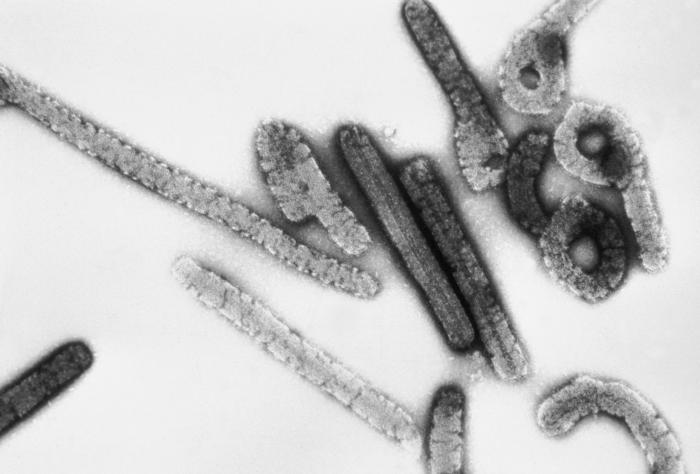Viral hemorrhagic fevers
They represent a serious health problem in the tropical areas. Viruses occurring mainly in endemic areas (sub-Saharan Africa, Siberia, etc.) are involved in the etiology of hemorrhagic fevers. Some viruses have adapted to interpersonal transmission from natural reservoirs (especially monkeys) (mainly Lassa and Ebola fever).
Clinical course
- At the forefront are symptoms arising from hemorrhagic diathesis - caused by inflammatory changes in the capillaries, thrombocytopenia, disorders coagulation and liver dysfunction;
- mortality rate is high (Ebola up to 88%);
- differentiation of individual viral hemorrhagic fevers according to the clinic is not possible;
- Accurate diagnosis is still possible just serologically.
Representatives of hemorrhagic fevers
Hemorrhagic fevers caused by Arenaviruses occur predominantly in endemic areas. The reservoir of the virus are 'rodents' ( Calomys spp. , Mastomys natalensis ). Diseases include fever, erosion, nausea, cutaneous hemorrhage, diarrhea, vomiting, renal insufficiency and nerve disorders ( hearing loss, imbalance…). Treatment is 'symptomatic' , interferons (IFN) or convalescent serum can be applied, we try to prevent shock in patients. Epidemiological rules must be observed when contacting the patient. Diagnosis is determined serologically because virus isolation would be too dangerous. vaccines are being developed, the protective effect of which has so far been tested in monkeys.[1]. The most prominent representative of this group is the Lassa virus.
Virus overview
| Virus | Occurrence | Disease | Lethality rate | Treatment | Prevention | Notes |
|---|---|---|---|---|---|---|
| Lassa | West Africa | hemorrhagic fever | 30–60 % Cite error: The opening <ref> tag is malformed or has a bad name |
ribavirin intravenously Cite error: The opening <ref> tag is malformed or has a bad name |
recombinant vaccine | |
| Junin | Argentine | Argentine hemorrhagic fever | — | ribavirin intravenouslyCite error: The opening <ref> tag is malformed or has a bad name |
live vaccine | often Hospital-acquired infection |
| Machupo | Bolivia, Paraguay, Brazil | Bolivia hemorrhagic fever | 30 %Cite error: The opening <ref> tag is malformed or has a bad name |
— | — | occurs rarely |
| Guanarito | Venezuela | Venezuela hemorrhagic fever | — | — | — | interhuman transmission have not been observed |
Ebola fever
- Agent – filovirus;
- occurrence – Zaire, Sudan aj.;
- signs – hematemesis, bloody diarrhea, often lethal within several days.
Marburg disease
- The first disease - 1967 in Europe (Marburg, Belgrade), infected while handling the blood of Ugandan monkeys;
- agent - 'filovirus' ;
- transmission from monkeys, even by direct contact;
- clinical course:
- bleeding and necrosis in virtually all organs;
- begins with muscle and joint pain, headache, fever, vomiting, diarrhea (up to dehydration and renal failure);
- 5. – 8. day - maculopapular rash (first on the face);
- CNS involvement - confusion, unconsciousness, coma;
- in severe case, death within 15-20 days.
Crimean hemorrhagic fever
- Tick-borne disease;
- occurrence - especially in Asia;
- it also has an African equivalent, its course is usually milder.
Omsk hemorrhagic fever
- Agent - flavivirus;
- clinical course:
- in the foreground are fever, headache, GIT disorders and hemorrhagic syndrome;
- hemorrhage occurs on the palate, nosebleeds, GIT and uterus;
- in 40% atypical pneumonia;
- lethality 1-2%, convalescence is lengthy.
Hemorrhagic fever with renal syndrome
- Agent: hantavirus; named after the Korean River ? dg = dbrw & newdg = 1 Hantan, where they were first discovered.
- Occurrence: in natural foci, the disease has been known in the Far East for hundreds of years, epidemic cases in the Balkan Peninsula (eg around Plitvice Lakes) have been described since the mid-1950s, sporadic cases also occurred with a very mild course on the territory of the Czech Republic (South Moravia) and Slovakia.
- Ways of transmission: the reservoir are rodents, the infection is transmitted by contact with urine, saliva or feces of rodents.
- Incubation period: most often 1 to 2 weeks, maximum 40 days.
- Symptoms: fever, myalgia, headache, nausea, petechiae and conjunctival haemorrhage. In more severe cases epistaxis, massive proteinuria, macro hematuria, melena, pituitary bleeding, perirenal hematoma.
- Treatment: symptomatic, in renal failure syndrome hemodialysis.
Yellow fever
Links
Similar articles
Source
- BENEŠ, Jiří. Studijní materiály [online]. ©2010. [cit. 15-11-2010]. <http://jirben2.chytrak.cz/materialy/infekceJB.doc>.
- PETRŮ, K., M. PEJČOCH a V. MONHART. Hemoragická horečka s renálním syndromem.. Časopis lékařů českých. 23/1997, roč. 136, s. 739-740, ISSN 0008-7335.
References
- BEDNÁŘ, Marek. Lékařská mikrobiologie : bakteriologie, virologie, parazitologie. 1. vydání. Praha : Marvil, 1996. s. 257-259. ISBN 80-238-0297-6.


